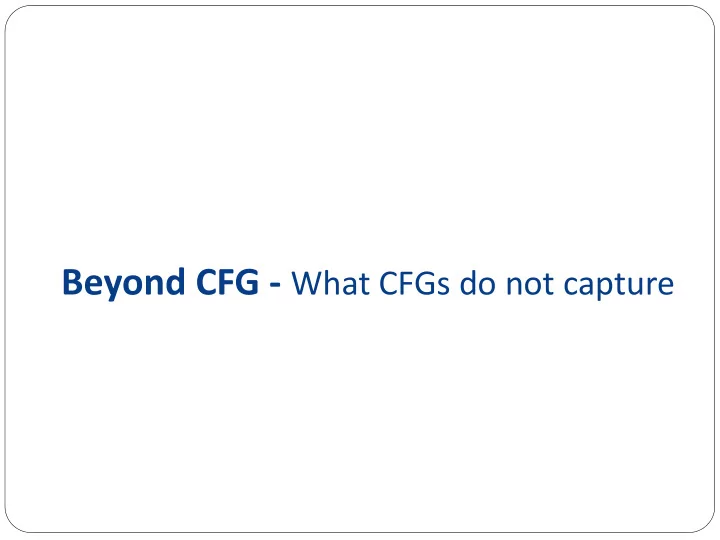

Beyond CFG - What CFGs do not capture
What CFGs do not capture Last class, we talked about “ over-generation ” problem of CFG Today, we will think about “incorrect analysis” of natural language when using plain CFG Non-projective dependencies Non-local dependencies Interpreting missing/displaced constituent
Plan for the Talk What CFGs do not capture Non-projective dependencies Non-local dependencies Interpreting missing/displaced constituent
Non Projective Dependencies Projective dependencies: when the tree edges are drawn directly on a sentence, it forms a tree (without a cycle), and there is no crossing edge. Projective Dependency: Eg: Example taken from Mcdonald and Satta (2007)
Non Projective Dependencies Projective dependencies: when the tree edges are drawn directly on a sentence, it forms a tree (without a cycle), and there is no crossing edge. Non-projective dependency: Eg: Example taken from Mcdonald and Satta (2007)
Exercise which word does “on the issue” modify? We scheduled a meeting on the issue today. A meeting is scheduled on the issue today. Use Stanford Parser to draw parse trees 1. http://nlp.stanford.edu:8080/parser/index.jsp Do they seem correct? If not, draw correct structure 2. Draw the structure directly on a sentence, and 3. determine projectivity/non-projectivity
Plan for the Talk What CFGs do not capture Non-projective dependencies Non-local dependencies Interpreting missing/displaced constituent
Local Dependencies Local dependencies generally cover the following two: 1. Arguments relations subjects, objects, complements… 2. Adjuncts/Modifiers adjectives modify nouns adverbs modify verbs or adjectives PPs modify NPs or VPs
Long-range Dependencies Most argument relations are local, but some are long- range Bounded long-range dependencies Unbounded long-range dependencies
Bounded Long-range Dependencies What is the subject argument of “sleep”? Raising: He seems to sleep in NLP class. -- you cannot say “ what does he seem?” Control (subject-object): He likes to sleep in NLP class. -- you can say “what does he like?” He promises her not to sleep in NLP class. She persuades him not to sleep in NLP class. Example taken from Julia Hockenmaier
Bounded Long-range Dependencies What is the subject argument of “sleep”? Raising: He seems to sleep in NLP class. -- you cannot say “what does he seem?” Control (subject-object): He likes to sleep in NLP class. -- you can say “what does he like?” He promises her not to sleep in NLP class. She persuades him not to sleep in NLP class. Example taken from Julia Hockenmaier
Unbounded Long-range Dependencies -- 1. Extraction What is the object argument of “like”? Wh-movement the guy that [I believe Peter told me you thought] you like. who do [you believe Peter told you I thought] I like? Topicalization: That guy, [I believe Peter told me you thought] you like. Clefts: It’s that guy that *I believe Peter told me you thought+ you like. Example taken from Julia Hockenmaier
Unbounded Long-range Dependencies -- 1. Extraction What is the object argument of “like”? Wh-movement the guy that [I believe Peter told me you thought] you like. who do [you believe Peter told you I thought] I like? Topicalization: That guy, [I believe Peter told me you thought] you like. Clefts: It’s that guy that [I believe Peter told me you thought] you like. Example taken from Julia Hockenmaier
Unbounded Long-range Dependencies -- 2. Coordination (and, or) What is the object argument of the verb highlighted in red? Right-node raising: [[She bought] and [he ate]] bananas. Argument-cluster coordination: I give [[you an apple] and [him a pear]]. Gapping: She likes sushi, and he sashimi Example taken from Julia Hockenmaier
More on Coordination (Exercise) What is the difference among the following examples? She bought and ate bananas. She bought bananas and apples. She bought bananas and he ate apples. She bought and he ate bananas. I give you an apple and him a pear.
More on Coordination What is the difference among the following examples? She bought and ate bananas. She bought bananas and apples. She bought bananas and he ate apples. She bought and he ate bananas. I give you an apple and him a pear. Coordination of non-constituents is challenging!
Unbounded Long-range Dependencies -- 2. Coordination (and, or) What is the object argument of the verb highlighted in red? Right-node raising: [[She bought] and [he ate]] bananas. Argument-cluster coordination: I give [[you an apple] and [him a pear]]. Gapping: She likes sushi, and he sashimi Coordination of non-constituents is challenging! Example taken from Julia Hockenmaier
Plan for the Talk What CFGs do not capture Non-projective dependencies Non-local dependencies Interpreting missing/displaced constituent
Transformational Grammar When using CFG analysis, some constituent seem to be displaced or missing. Passive: “The homework was eaten.” No NP object, even though “eat” usually requires one. Question: “What did my horse eat?” The object of “eat” precedes the subject. Elliptical constructions: “I will submit my homework, if I can _____.”
Transformational Grammar Transformational Grammar considers “a sequence of” parse trees for each sentence. The first parse tree is called as “ deep structure ”. The actual parse tree for the observed sentence is called as “ surface structure ”. Deep structure has all the displaced or missing constituents in their canonical locations. Semantic relations (thematic roles) are more transparent at deep structure. The observed sentence is called as “surface structure”. “ transformation rules ” permute, delete, and insert elements in trees, arriving at the observed sentence.
Examples of Transformation Passive: Deep: “(My horse) ate the homework.” Surface: “The homework was eaten.” Question: Deep: “My horse ate what” =>what my horse ate =>what did my horse ate Surface: “What did my horse eat ?” Elliptical constructions: Deep: “I will submit my homework, if I can submit my homework.” Surface: “I will submit my homework, if I can _____.”
Final Quiz Give a new example of a sentence with non-projective dependency Give a new example of a sentence with non- constituent coordination.
Recommend
More recommend